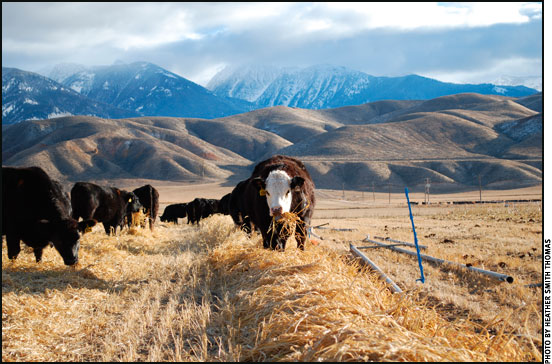Summer Annuals Extend Fall Grazing
Researchers evaluate warm-season annuals for fall and winter grazing.
Extending the grazing season can help reduce production costs. In dry climates ranchers often run short of fall pasture, especially when productivity of cool-season perennial grasses is limited during the heat of summer. In 2008, researchers at the University of Idaho's Nancy Cummings Research, Extension and Education Center, Salmon, Idaho, began looking at ways to extend grazing with summer annuals.
John Hall, extension beef specialist, worked with test plots for three years. When irrigation was available during the 60-day growing season, some species produced 2 to 3 tons per acre. Part of the plot was given only a month of irrigation, with water turned off Aug. 1 to simulate what happens on many ranches.
The first test plots contained five species of warm-season annuals — Sudex, Teff (a grass), German foxtail millet, pearl millet and grazing corn — planted July 1. Production varied from 0.5 tons per acre for pearl millet with no irrigation after early August to 5.6 tons per acre for Sudex with full-season irrigation. Sudex, German foxtail millet and Teff all produced more than 2.5 tons per acre in less than 60 days.
The next two years, the same species were planted, but with a change from grazing corn to a short-season silage corn to get more tonnage.
"We also used white proso millet. One reason for planting late (since we planned to graze once, in the fall) is that these plants provide maximum yield by then and still have good nutrient quality. For example, corn is usually producing tassels and silk by then, but not much grain formation. The other species have headed out, but are not mature." The frost hits at that stage, and it doesn't become overly mature.
"With corn, you're grazing frosted standing corn instead of stalks, with more nutrients in the total plant. During the three years, our nutrient analyses — with frost hitting the plants at their maximum growth stage but before they become mature — showed crude protein levels between 9% and 10% on the low side, and on the high side between 13% and 14%. Energy values also exceed what dry cows need after weaning calves," Hall says.
This would be ideal grazing for young cows or any that lost body condition while raising calves.
"This is something we can graze without need for supplementation. Sorghum-Sudan grass was a close second to corn for production, followed by German foxtail millet. These are all excellent species if you plan to graze them once. If you have opportunity to graze twice, Teff produces a crop so quickly that you can graze it several times. It does require a prepared seedbed, however," he explains.
"We strip-grazed in the fall. On sudex and corn we got 70 animal grazing days per acre. German foxtail millet gave about 60 animal grazing days per acre," Hall said. "We learned that sudex and corn work well if you graze after snowfall. They stand up, and cattle can get to it." If you plan to graze other species after snow, Hall suggested you might have to put it in windrows.
"If it's light snow, cattle continue to graze millets, but these mash down in heavy snow," he explained. "As long as it doesn't crust over, cows dig for it if they know it's there, but sudex and corn worked better because there was always something sticking up for cows to grab and pull out of the snow. We grazed that in December."
[Click here to go to the top of the page.]













